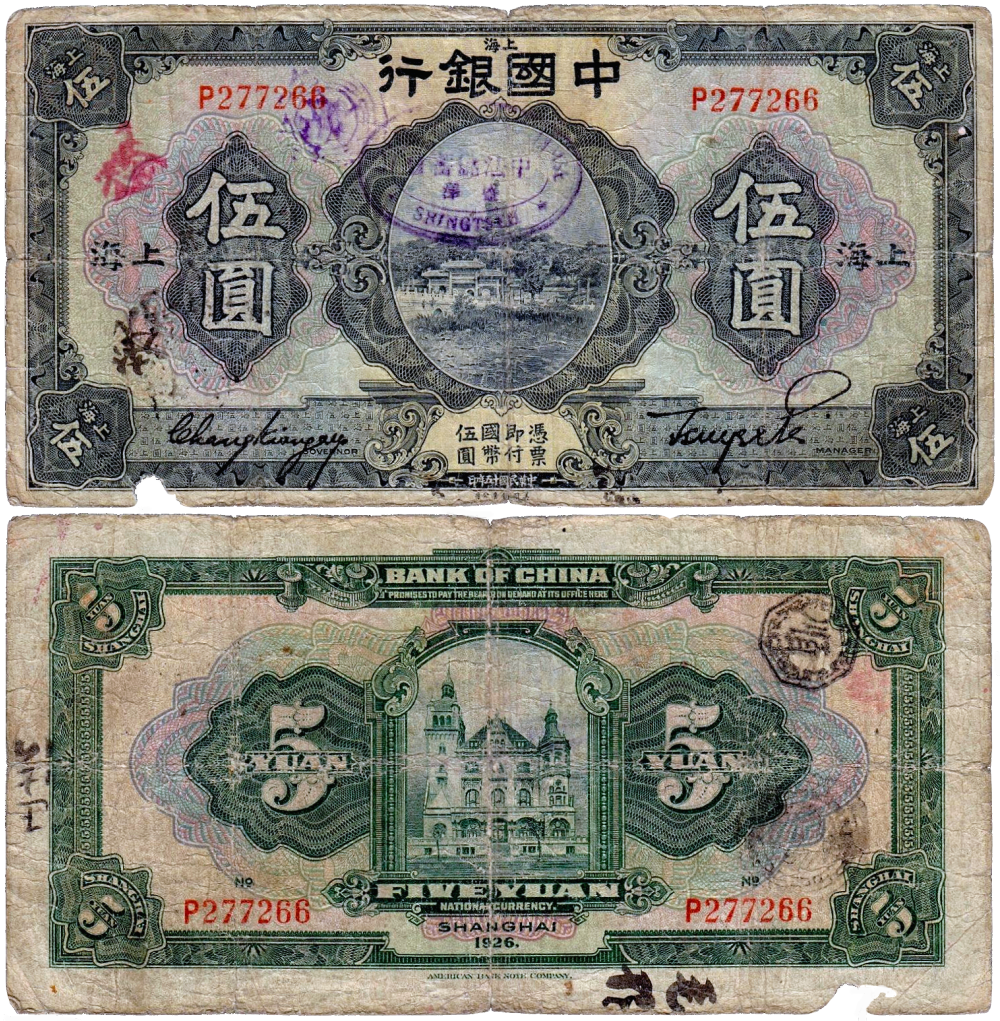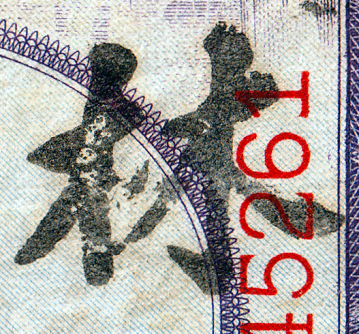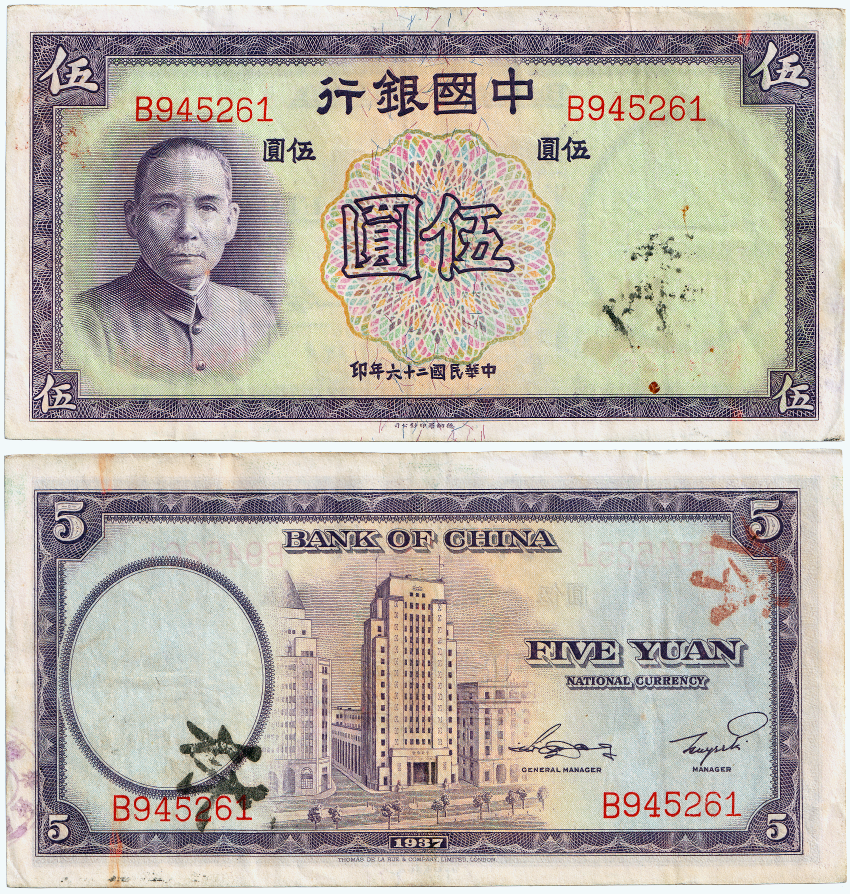|
|
New, September 2020
|
Script, Scrawl and Chops
A study of various examples of unofficial additions to paper money, usually in the form of various written scripts, signatures or chops (seals) and rubber stamps. These vary considerably in form and purpose, from the relatively banal, to the historically significant. Some have no relation to the use as money whatsoever.
This will be an expanding study. The examples are listed by issuer; bank or type.
This will be an expanding study. The examples are listed by issuer; bank or type.
The Bank of China - 中國銀行
|
Right: Bank of China $10 of 1918 (and issued c1923), Fukien. SCWPM 53, S/M C300-102. The vignette depicts the South entrance to the Hall of Great Accomplishment, Temple of Confucius, Peking (Beijing) with avenue of trees This note is technically identified as SCWPM 53f, but has unlisted (official?) branch overprints in Chinese and English specifying Foochow (Fuzhou). Scarce. Other examples are known. In addition this note has at least 25 unofficial chops and annotations across both sides. Some of the chops are studied below: |
Above: (first from left) a chop found on the front vignette, containing the single character '正', which generally means "right, proper, correct". As with a Central Bank of China example (different character but similar meaning), it may be more a comment on the authenticity of the note than anything to do with whoever applied the stamp. (centre left) a single character chop, as yet unidentified. The radical of the character appears to be 水. (centre right) A single character chop: '永'. meaning "forever, eternal" and is sometimes used as a surname. (right) a very distinctive chop containing the single character '新', meaning "new, fresh, modern" most likely in reference to the name of the business which chopped the note, and how it was hoping to be perceived. Alternately, it is again sometimes a surname.
|
Right: Bank of China 10 yuan National Currency, Shanghai, 1924. SCWPM 62'c', S/M C294-140c. The front vignette depicts the Imperial Summer Palace at Peking (Beijing) This has a varied range of at least 14 chops and annotations across both sides in a variety of styles. The most distinctive on the front is the bordered circular chop containing '元'. This is often used as a symbol for dollars/yuan. It can also mean head (as in chief), and is used as a surname. |
|
Right: Bank of China 10 yuan National Currency, Shanghai, 1924. SCWPM 62'c', S/M C294-140c. This example has over 25 chops and annotations, with an even greater variety than above. One of the more decipherable on the front is the square blue chop at the lower right. This contains the character '馬', "horse". It also a common surname among Hui Muslim families. The largest of the chops on the back, located at the lower left, contains the character '良' in the right hand field of the circle; "good, virtuous, respectable". This most likely refers to the business. There appears to be a pattern or possibly characters in a seal script in the left hand field of this chop. |
|
Right: Bank of China 5 yuan National Currency, Shanghai, 1926 (issued 1928-35). SCWPM 66a, S/M C294-160e. Several chops and annotations to both sides. The most noticeable example on the front is mostly illegible. Helpfully however, the most readible portion indicates that the note passed through a business in Shingtseh (Shengze), Kiangsu (Jiangsu) Province; described in 1925 as "a producing center of silk and light silk piecegoods". This town is a district of Suchow/Soochow city (Suzhou) near Shanghai. It is now one of the largest producers of textiles worldwide. The most noticeable chop on the reverse is a hexagonal stamp containing '順' at the centre; to obey; to follow, favourable. |
|
Right: Bank of China 5 yuan National Currency, Shanghai, 1926 (issued 1928-35). SCWPM 66a, S/M C294-160e.
There is one small red chop and a single small annotation in the margin on the back of the note. However the main point of interest here is the business name stamped twice on the front and once on the back, for a Zue Fong Lumber Co. Shanghai, presumably located/operating principally within the International Settlement, as the stamp carries no Chinese text. A Shanghai telephone directory of 1947 (at least five years after this note would had been withdrawn) lists a 'Zue Foong Lumber Hang'. Zue Fong means Full (fat?) Buddha, probably in reference to the well known (images of) 10th century Chinese monk Budai. |
|
Right: Bank of China 5 yuan National Currency, Tientsin, 1931 (early signature type). SCWPM 70a, S/M C294-180. There are at least 10 chops across the back, mostly very faded. The vertical string of violet text on the left side is: 中國民華廿伍年六月拾壹日(?), and possibly translates as "the First Day of June in the twentieth year of China", though the 13th and final character is still to be identified. |
|
Right: Bank of China 5 yuan National Currency, 1937. SCWPM 80, S/M C294-221. An unusual example with a pair of differently colored but clearly matching characters stamped on the back. Most likely not applied for the more usual reasons, their purpose remains a mystery: Below left: 体, "body; group, class, body, unit" Below right: 林, "woods; forest - also a surname" |















